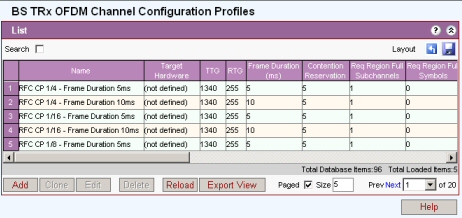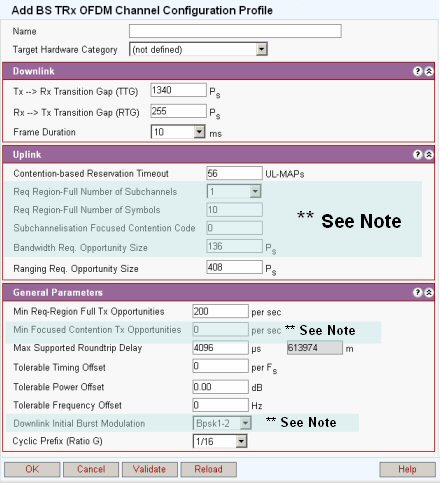
BS TRx OFDM Channel Configuration Profiles package is defined for the specific target hardware category. The BS TRx Channels of different categories will not be able to have wrong profile assigned.
The exception is category (not defined), which is maintained for backwards compatibility purposes with older versions of Netspan databases.
Profiles of (not defined) category cannot be used for MicroMAX.

For definitions of list headings see 'Add/Edit BS TRx OFDM Channel Configuration Profile' below
See Action Buttons

** Note: The fields in the shaded area are not available to MicroMAX
Name: Length 2 to 64 characters. Allowed characters 0 to 9, A to Z, a to z, ., #, -, _
Tx=>Rx Transition Gap (TTG): This sets the gaps between the uplink and downlink frames on TDD to allow the change in the direction of transmission at the SS. This is calculated as 4/fs where fs =1.14 x the channel bandwidth. (1 microsecond at 3.5mHz)
Rx=>Tx Transition Gap (RTG): See Tx=>Rx Transition Gap (TTG) above.
Frame Duration: Select from available Values = 2.5, 4, 5, 8, 10, 12.5, and 20 ms. The longer the frame duration the greater the latency.
Contention-based Reservation Timeout: The number of UL MAPs to receive before contention based reservation is attempted again for the sane connection Unit= number of UL-MAPS Range = 1 to 255.
Req Region-Full Number of Subchannels: The SSs requests bandwidth in the frame header. Some SSs can only make requests on the full channel but some SSs are capable of making requests in a sub channel or group of sub channels. Set this to govern how many sub channels are allocated in a bandwidth request. Select From 1, 2, 4, 8 and 16 subchannels (16 essentially represents full).
Req Region-Full Number of Symbols: Used to govern how many symbols are allocated in a bandwidth request. The table below shows the number of symbols that must be set to ensure that a bandwdith request can be sent.
|
Req Region-Full Number of Subchannels: |
Req Region-Full Number of Symbols: |
Min Subchannel Req Region Full Tx Opp |
Channelisation |
|
1 |
11 |
800 |
Sixteenth |
|
2 |
6 |
400 |
Eighth |
|
4 |
4 |
200 |
Quarter |
|
8 |
3 |
100 |
Half |
|
16 |
2 |
100 |
Full |
 Very
Important: Unless the required number
of symbols are made available as above the SS will not be able to send
a bandwidth request and will be unable to operate.
Very
Important: Unless the required number
of symbols are made available as above the SS will not be able to send
a bandwidth request and will be unable to operate.
Sub-channelisation Focused Contention Code: Not Supported
Bandwidth Req. Opportunity Size: Size (in units of PS) of PHY payload that SS may use to format and transmit a bandwidth request message in a contention request opportunity. The value includes all PHY overhead as well as allowance for the MAC data the message may hold. 68PS/symbol rounded down to the nearest symbol. Not Supported
Ranging Req. Opportunity Size: Size (in units of PS) of PHY payload that SS may use to format and transmit a RNG-REQ message in a contention request opportunity. The value includes all PHY overhead as well as allowance for the MAC data the message may hold and the maximum SS/BS TRx round trip propagation delay. Not Supported
Min Req-Region Full Tx Opportunities: The number of bandwidth requests per sec
Min Focused Contention Tx Opportunities. Not Supported
Max Supported Roundtrip Delay µs: Recommended value = 4096. The grey box to the right of the field displays the Max Supported Round Trip Delay as the "Max cell size in meters"
Tolerable Timing Offset per FS: Recommended value = 0.
Tolerable Power Offset dB: Recommended value = 0.00.
Tolerable Frequency Offset Hz: Recommended value = 0.
Downlink Initial Burst Modulation: (not supported on MicroMAX). This is the modulation that will be used for broadcast traffic in the downlink, and so should not be set at a modulation higher than what all deployed SS can receive. The default is BPSK1/2.
Guard
Interval Ratio G. This sets the ratio of the cyclic prefix to frame
size to allow a guard to be placed between symbols to reduce the effects
of multipaths. The cyclic prefix is sized appropriately to serve as a
guard time to eliminate intersymbol interference. This is accomplished
because the amount of time dispersion from the channel is smaller than
the duration of the cyclic prefix. A fundamental trade-off is that the
cyclic prefix must be long enough to account for the anticipated multipath
delay spread experienced by the system. The amount of overhead increases,
as the cyclic prefix gets longer. The sizing of the cyclic prefix forces
a tradeoff between the amount of delay spread that is acceptable and the
amount of Doppler shift that is acceptable.
|
Cyclic Prefix 3.5GHz Bandwidth |
||||
|
CP |
1/32 |
1/16 |
1/8 |
1/4 |
|
TG(us) |
2 |
4 |
8 |
16 |
See Action Buttons